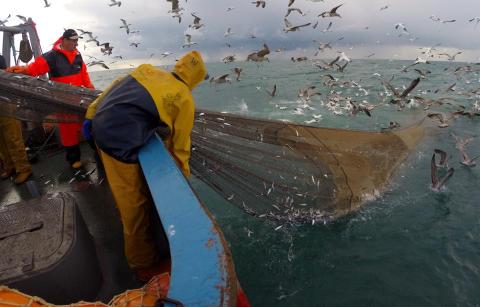
- Many recent studies have characterised shifts in the distribution of fish and shellfish around the UK and Ireland that correlate with observed climate change. Cold-water species have declined in both abundance and geographical range, for example the Atlantic wolffish, most notably in the southern part of the North Sea.
- Large numbers of Atlantic bluefin tuna have been reported off the UK and Ireland since 2014 associated with warm marine conditions, and possibly climate driven changes in prey availability (e.g. Mackerel)
- Several species of cephalopods (especially squid) have shown noticeable increases in abundance and geographical spread in UK waters, a change consistent with warming waters.
- For many fish stocks assessed by fishery scientists, juvenile recruitment to the population during recent consecutive warm years in 2020 and in 2021 was low. The exceptions to this were some of the pelagic species (Atlantic mackerel, North Sea sprat, Irish Sea herring, blue whiting) and warm-water species (e.g. Western English Channel sole).
- Several studies have documented large episodic shocks to fisheries as a result of marine heatwaves and cold-spells. In the North Sea, catches of sole and seabass increased in years following cold-spells whereas catches of red mullet and edible crab decreased, impacts of heatwaves were less clear.
High evidence, medium agreement
Since the last MCCIP assessment in 2020 (Pinnegar et al. 2020), many more studies have been published on the changing distribution of species or climate impacts on recruitment patterns etc. – but there remains limited information on heat waves and storminess. Some of the information available is annecdotal in nature or is difficult to ‘attribute’ to climate change with any certainty. In addition, while there is abundant information on observed biological impacts (see the MCCIP report on ‘fish’, by Fox et al. 2023), there is much less on consequences for fleets and fishing communities. That being said, much can be learnt from a recent UKRI sponsored exploration of seafood industry resilience in the light of the Covid-19 pandemic (Franco 2023). This involved data collection through structured interviews and surveys; modelling of the industry supply network to explore systemic and unintended consequences for resilience; and in-depth case studies to investigate business model adaptation (Franco 2023).
‘Fisheries research’ remains one of the most active fields in marine science, with a huge body of existing work over the past 100 years, and new papers appearing all of the time. Hence, the amount of available evidence is judged as being ‘high’, but the level of agreement and consensus is still judged as being ‘medium’. Consequently, the overall assessment has not changed from the 2020 MCCIP Report Card.
- Of all the species examined in a recent study, around half were predicted to benefit from more suitable habitat within the UK Exclusive Economic Zone (EEZ), including black seabream, seabass, sardine, red mullet, anchovy and pouting. Conversely, it is suggested that UK seas will become less suitable for species such as saithe, Atlantic wolffish, starry ray, halibut, ling, megrim and lemon sole.
- For the UK, it is estimated that direct potential losses due to reduced shellfish production associated with Ocean Acidification (OA), could range from 14% to 28% of fishery Net Present Value (NPV) by 2100.
- In a recent climate change risk assessment for 380 fishing fleets and 105 coastal regions in Europe, those in northern England and southern Scotland were identified as being particularly ‘at risk’, largely as a result of high stock sensitivity and low catch diversity.
High evidence, low agreement
The number of projection studies of relevance to the UK and Ireland has gone up dramatically in recent years, hence the shift to the right in the confidence matrix above, recognising an increase in the ‘amount of evidence’. Furthermore, many projection studies now make use of ‘ensembles’ of subtly different biological models in order to better characterise uncertainty, when this was not often the case in the past. However, there are still considerable uncertainties and disagreements about the trajectory of primary productivity and this has knock-on impacts for fisheries yield projections in particular. Similarly, there are still some contradictions in the ocean acidification literature, with some projections suggesting considerable economic losses (e.g. Mangi et al. 2018) and others suggesting negligible impacts (e.g. Townhill et al. 2022) in the future.
- As species continue to shift their distribution, the need for ‘adaptive’ transboundary quota allocations or ‘quota swaps’ will remain a key challenge. In addition, trans-boundary trading of fish and shellfish could be problematic following the exit of the UK from the EU. At the moment most of the fish consumed within the UK (e.g. cod and haddock) are imported from northerly countries such as Iceland and Norway, whereas most of the fish or shellfish caught in the UK are exported to countries further south (see Harrison et al. 2023), where consumers have a tradition of eating these species. This can be viewed as ‘climate maladaptation’.
- More work is needed on deriving effective climate change adaptation measures for fisheries. Elsewhere in the world, a wide diversity of interventions have been tried or advocated (see Poulain et al. 2018), while in the UK and Ireland, comparable discussions are only just beginning. The UK Seafood Fund: Fisheries Industry Science Partnerships (FISP) scheme does include climate change as one of its core themes, but so far very few projects have focussed on this issue.
- Increasing attention is being given to the role that fisheries play in generating carbon emissions and how to achieve ‘net zero’ emissions by the year 2050 (i.e. climate change ‘mitigation’ rather than impacts or adaptation). Added to this, greater focus is being placed on the resuspension of buried carbon by trawling activity, and whether restrictions of fishing activity in marine protected areas could have benefits for climate change mitigation.
- Inadequate or contradictory projections of future storminess and of future primary productivity, make assessments of consequences for commercial fisheries very difficult.